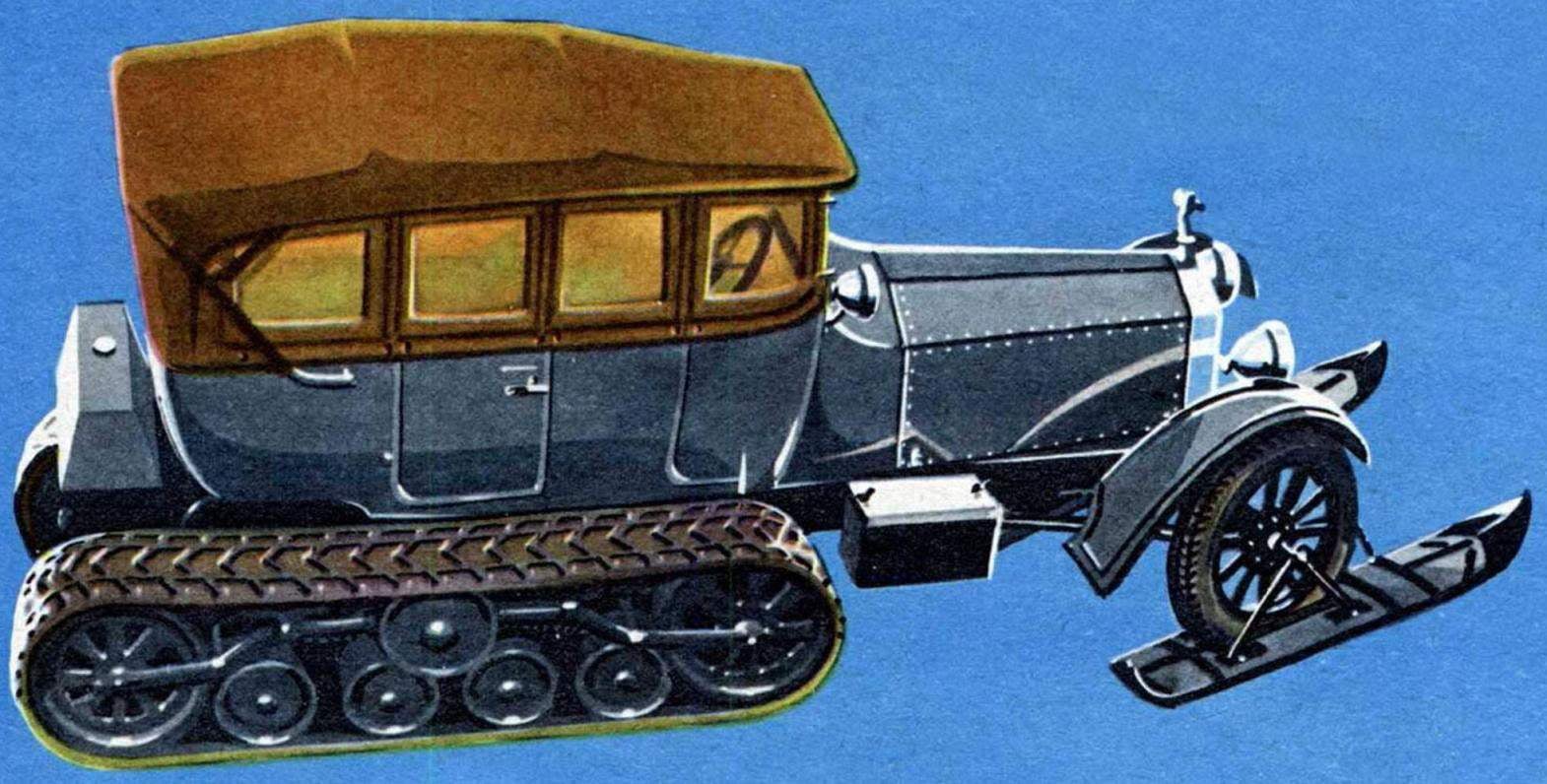 Lenin in Gorki near Moscow in the spacious garage, which is included in the exposition of the House Museum of V. I. Lenin, it is an unusual machine: instead of rear wheel rollers with wearing them on the tracks under the front skis. For several years she has served the Vladimir Ilyich when traveling on snow-covered roads of the Hills in surrounding villages and in Moscow. Today our story about the history of this unique vehicle-the all-terrain vehicle and further development of such structures.
Lenin in Gorki near Moscow in the spacious garage, which is included in the exposition of the House Museum of V. I. Lenin, it is an unusual machine: instead of rear wheel rollers with wearing them on the tracks under the front skis. For several years she has served the Vladimir Ilyich when traveling on snow-covered roads of the Hills in surrounding villages and in Moscow. Today our story about the history of this unique vehicle-the all-terrain vehicle and further development of such structures.
…French mechanic Adolf Kegress in his youth left their homeland in search of work. Fate brought him to St. Petersburg, where in 1904 he took a job in the court garage. There he began experiments with a mechanism that, in his view, was to significantly improve the car’s traction on snow. The first experiments Kegress held in 1909, and by 1913, the ninth has already created a workable design half-track mover, tested on domestic cars “Lessner Mercedes” and later on “Russo-Balt”. In 1914, in his catalogue of the Russian-Baltic plant along with pictures and technical characteristics of cars and trucks to put the photos and short description half-track vehicle with driver A. Kegress.
What’s the idea device? Instead of the rear wheels the car was rubber tracks. On each side they covered the two large hollow roller, a unified system of tubular rods in the cart. The middle part of the rubber tracked tape was pressed to the road four anchor roller. Each caterpillar was able to swing relative to the rear axle. On the axles instead of wheels sitting sprockets, chains which transmit rotation of the large rollers on the back. Thanks to the significant support surface caterpillars of the specific ground pressure was 0.08 kg/cm2.

The front wheels were equipped with skis. They distributed the weight of the vehicle, comes on the front wheels, the large contact area and has also provided small specific pressure of about 0.11 kg/cm2. The ski was pivotally connected to the axles of the wheels and their surfaces were made the cutouts for the tires. Thus, on the solid road, the car could go without touching her skiing.
A. Kegress got in 1914 in Russia on the device privilege (the so-called document fixing the copyright for the inventor), and later, in 1917, he patented it in France.
Held in February 1914, the testing machines with the propeller (the motor sleigh, or “kegresse”) have proven their practical suitability. So, the magazine “Motor” (1914, No. 3) wrote: “the Route of their movement passed on the ordinary road and in deep snow, ruts, potholes, snowdrifts. Machine successfully overcome all the obstacles encountered on the way. On good sites the way they developed a speed of 56 miles per hour.” For reviews of foreign experts, “Russia was the only country that has such advanced technology”.
In the first world war became obvious that we had in the Russian army armored vehicles for the military action in the winter. A former teacher of the armored Academy named after Malinovsky V. D. Mostovenko in the book “Tanks”, talking about the history in our country of tracked combat vehicles, notes that in those years the best device that increases the flow of cars in winter conditions, were deemed “kegresse”. He recalls that in 1915 for the Russian army at the Putilov factory was ordered armored half-track vehicles.


Fig. 1. The scheme of the sleigh on the basis of the car “rolls-Royce” (about the device controls, shield devices, as well as the engine described in detail in “M-K” No. 4, 1977).

Fig. 2. Diagram of the device of caterpillar tracks.
In official documents they were regarded as “Russian type of tank”. Indeed, half-track armored cars fulfilled their tasks even more successfully than they could perform, for example, French light tanks, is considerably inferior to the Russian machines in mobility.
Kegress, establishing the manufacture of sleigh at the Putilov factory, found a mate — a talented mechanic Alexey Yelizarov. Subsequently Elizarov has played a significant role in the release of three hundred kits of parts ordered by the plant for conversion to crawler vehicles, trucks, staff and ambulances. But after the departure of A. Kegress home in 1917, he took charge of all these works.
Putilov factory installed tracks on armored cars “Austin”, and cars “rolls-Royce”, “Packard”, trucks “Morse”. Almost two hundred of these machines were serving at the front.
In the fall of 1919, when Yudenich was advancing to Petrograd, the way catchers have received an urgent order for the red Army on the party of armored cars, equipped with “kegresse”.
The significance of this technology for the defense of the young Soviet Republic CAN be judged BY the interest that was shown by V. I. Lenin to their production. In a letter to Petrograd from December 15, 1919, he asked: “is it possible to order quickly 2 sleigh (sleigh kegress) heavy and 2 light for the southern front? Hastily. Answer”. In the second letter dated 23 December of the same year Vladimir Ilyich was worried, “Why no more regresso? Tapes, say more than 100?”
However, work became more difficult: not enough raw materials, the workers with weapons in their hands went to the front. Soon, the Putilov factory was stopped. Only in November 1921, he earned again. And one of the first orders was to repair the sleigh for Lenin…
V. I. Lenin 1919 used car “rolls-Royce” model of 1916, converted to half-track the progress of the Putilov plant. Structurally, the machine has a lot in common with another of Lenin’s car (see “M-K”, 1977, № 4), which is now located in the exposition of the Central Museum of V. I. Lenin.

Fig. 3. The interior of the body (left door removed).

Fig. 4. Front axle, steering linkage and ski.
Why did you choose “rolls-Royce”? It was a very reliable car with a spacious body. She was quite powerful at the time engine (about 65 HP), good suspension and have progressed through the snow with a full load sufficiently high speed.
Body, engine, transmission, steering remained unchanged. The alteration only affected the suspension. Instead of rear wheels mounted rubber caterpillars, and the leading made, and large front and rear rollers. Rotation thereto transmit chains, two on each side, and the upper branch of the caterpillars were supported by additional roller.
The old front axle was replaced by a powerful wrought-iron beam, which was provided for hinged skis and springs of their suspension. Reliable and practical snowmobile.
And the inventor of the “regression”? Returning to France, he collaborated with firms “Citroen”, “Panhard-Levassor”, producing, in particular, for the army semi-tracked vehicles. Died A. Kegress in 1943 at the age of 64 years.
When our country is in the early thirties took over the mass production of cars, the idea of a half-track machine was not forgotten. The baton from the Putilov took Muscovites. So, in 1932, a group of designers scientific autotractor Institute NATI under the direction of engineer G. Sonkin started to create a machine based on truck GAZ-AA. Their offspring, NACHI-2 — the first Soviet “kegress” — has been successfully tested. As Lenin’s “rolls-Royce”, NACHI-2 had the rubber track with inner ridges and two of the leading drum on each side. The program was still a chain. The most successful half-track machines were working on the snowy roads, the snow, although he could go through the mud and the sand.
An improved variant of the NACHI-2 in 1933-1934 tested on the Taimyr Peninsula in Arctic conditions. Later, in 1935, was created (again to the base of the GAZ-AA) another half-track truck NACHI to B3. As NACHI-2, the mechanism of its caterpillar trucks closed casing. Prototypes of the NATI-VZ tested in Chukotka and after making refinements to the design was the inspiration for half-track car GAZ-60. Gorky plant adopted the “Kerschowski” relay and from 1933 to 1942 built this car in series. GAS-60 with a 50-horsepower engine weighed 3375 kg, can carry 1300 kg of cargo and has a top speed of 35 km/h Width of rubber crawler belt of this car was 390 mm, the same as on the car stored at Gorki Leninskie.
Half-course, design is similar to that was standing on the GAZ-60, and had experienced trucks, developed by the NATA in 1936. Further experiments Institute transferred directly to the plant ZIS (now ZIL), where in 1938 he was made an experienced half-track machines ZIS-22, and in 1941 a more sophisticated variant of the ZIS-22M. With the 73-horsepower engine ZIS-22, weighing without load 4660 kg could carry 2 250 kg of cargo at a speed of 35 km/h.
When the Great Patriotic war, the plant began to production of the ZIS-42. It was a modernized version of the ZIS-22 had and, in particular, wider (415 mm) rubber tracks. The first batch of these machines at the end of 1942, immediately sent to the Stalingrad front. Production of ZIS-42 and lasted until 1944.
Today, after several decades of development, when, and wheeled and tracked vehicles have a high permeability, half-track vehicles have become less relevant. But the biography of “regresso” still occupies a prominent place in automotive history.
L. SHUGUROV



